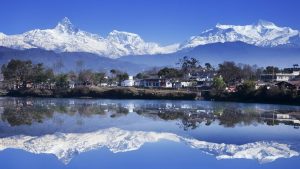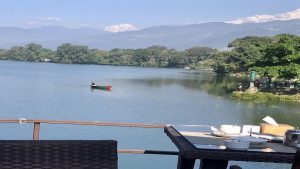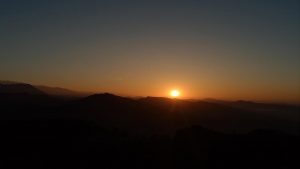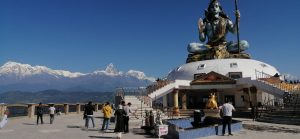Pokhara,Nepal




Pokhara (123 Sq. Km) s the one of the most beautiful city and second largest tourist destinations in Nepal. It is popular as “City of Lakes”. Pokhara is connected with all the major cities of Nepal with land transport. Regular flights also available from Kathmandu, Bharatpur(Chitwan) , Bhairahawa(Lumbini) & Nepalgunj. Pokhara is famous for sightseeing and mountain views. Phewa Lake, Begnas Lake and Rupa Lake are some of the major attractions. The mind blowing views of Annapurna range to the north of Pokhara including Annapurna I and VI, Annapurna South and Machhapuchhare gives you an amazing feeling. When the sun rises, you can see the reflection of the mountains in the lake, truly a photographer’s paradise.The place is an ideal place to visit for the travelers. It is also very much popular for the adventure activities. Most of the popular trekking in Annapurna region begins from here.
Most of the tourist visit Pokhara not only for sightseeing purpose but also for the other available optional activities like bungee Jumping, Paragliding, Zip Flyer, Hot Air Balloon,Ultralight flight, heli flights to Mountains, Sky diving etc. Pokhara was part of a once vibrant caravan route extending between India and Tibet. This is the land of the Magars and Gurungs who have earned worldwide fame as Gurkha soldiers. Brahmins, Chhetris and Thakalis are other major communities here.
Mountains that can be seen From Pokhara are :
The most spectacular sight in Pokhara is the sight of Annapurna range. See the following image which shows eight important mountains of the Annapurna range.
This range stretching from west to east includes Dhaulagiri, South Annapurna, Annapurna 1, Hiunchuli, Fish-tail (Machapuchare), Annapurna 3, Annapurna 4, and Annapurna 2. In Pokhara, the holy unclimbed mountain Macchapucchre (or also known as Fishtail Mountain), located in the middle of the Annapurna range, can be seen standing right in front of our nose.
Everyone in Pokhara wakes up early to greet the mountains during sunrise. The reflection of sunlight from a mountain is always a breathtaking site. You will never forget the sight of the fishtail mountain standing right before your eyes saying “Good Morning”
On your way to Pokhara, you can enjoy the beautiful picturesque scenes of the countryside. Enjoy the green hills, rivers, and every other thing you see during the flight or drive. Also, get several opportunities to look at the high peaks of Dhaulagiri, Manaslu, and Machhapuchhre. Among such peaks, you will also have the chance to encounter the cultural diversity of the region.
Phewa Lake and Barahi Temple: Beautiful Lake Phewa is the second largest lake in Nepal. It covers an area of about 4.43 sq km with an average depth of about 8.6m, maximum water depth is 19m. The reflection of Mount Annapurna can be seen on Phewa Lake. Another attraction of this lake is Barahi Temple made in pagoda style, which is an island in the middle of Phewa Lake.
Tal Barahi Temple’s courtyard resembles a little island. It is well-known among holidaymakers and tourists. The goings-on in the water does not affect the devotees’ worship. The visitors can reach the temple via boat. Thousands of Pokhara residents visit Tal Barahi Temple during Durga Puja and on Saturdays to worship the Goddess. This temple is the only one of its sort in Nepal, as it is built entirely within a lake with no land passageways.
Early evening enjoy walking, eating at the lakeside market on own then overnight
Lounging by the lakeside
The most laid-back activity on our list, enjoy your vacation and watch your stresses melting away as you lounge by the lake. You can take walks, bike rides, shop and even compose poetry with the lake as your muse. Try to capture the perfect reflection of the Annapurna range on the lake, on a camera.
Aarati
In every evening, you can watch Aarati which is a Hindu ceremony in which lights are lit and offered up to gods. The small space that overlooks the Barahi Temple sees hundreds of people—devotees, passers-by, tourists. Small benches are also available to sit if you reach early.
According to Hindu rituals, aarati is performed in remembrance of deities and to realize their greatness. The flame that the priests rotate in a circular fashion has a pious implication. The aarati platter has lighted wicks, which the devotees reach out and press gently against their forehead. The glowing lights are meant to chase away the darkness and welcome happiness and prosperity. While performing the ritual, one should not let their mind wander and must remain focused on visualizing god. It is also seen as a medium to express gratitude and forgiveness.
SARANGKOT:
The village of Sarangkot is situated at a height of 1600 meters on Sarangkot mountain, and is known for its panoramic Mountain and Himalayan views of Dhaulagiri, Annapurna, and Manaslu, as well as views of Pokhara and Phewa Lake. Sarangkot has been a paragliding destination in recent years. Sarangkot is just 11 kilometers from Pokhara’s Lakeside.
Sarangkot will surprise everyone visiting there with the magnificient and breathtaking Himalaya views and the most awesome and number one thing to do here is watching the sunrise and sunset that will make you feel as if you are in the piece of heaven itself. The Annapurna series, that also includes Annapurna I, which is the world’s 10th tallest peak, is seen from Sarangkot, one of the world’s biggest mountain ranges.
Seti River
An interesting tourist attraction of Pokhara is Seti River, which cuts gorgeously through the Mahabharat range and, therefore, seems to disappear in caves and tunnels in many places along its route through Pokhara city. At various points Seti is barely 2 m wide but its depth reaches an astonishing 20 m! The river gorge can be seen from several spots in the city ie Mahendra Pul, K.I. Singh Pul and Prithvi Chowk Pul. From these spots, the river can be seen in all its ferocity gushing down the deep gorge that it has carved over millennia. Seti which literally means the White River originates from the Annapurna Massif.
Gurkha Museum
Situated at Pardi, Pokhara, the museum displays a collection of uniforms, medals (including the Victoria Cross), pictures of the Gurkha infantry regiments, Gurkha engineers, signals and transport regiments and Gurkha contingent of the Singapore Police Force. GURKHA SOLDIERS joined the British Army since 1815 and later into the Indian Army after it’s independence in 1947. The MUSEUM concentrates on their history to current British Army and the Indian Army. The displays include hundreds of PHOTOGRAPHS of the many CAMPAIGNS they took part in and their REGIMENTAL LIFE. The 3-FLOOR GALLERIES are brought alive by SOUND and COLOURED LIGHT. Displays also include uniforms they wore, items they used and medals they won. Details of the Gurkha VICTORIA CROSS winners, the highest bravery medal with their citations can also be viewed.
Bindhyabasini Temple & Old Bazar
Bindhyabasini temple is situated on the hilltop and 915m from sea level. This religious place of Hindus living in the Pokhara region is devoted to the goddess Durga. Goddess Durga which is also known as Kali Mata is the symbol of a bloodthirsty goddess. Many people come here to worship and sacrifice animals. Experience the tranquility of the temple grounds as you offer prayers and seek blessings for prosperity and well-being.
Davi’s Fall
David’s falls is an amazing waterfall in Pokhara which is nearly 500 feet long and runs 100 feet below ground level. It is also known as Patale Chhango which means the underwater world. According to local old people, on 31st July 1961, a Swiss couple Davi went swimming but the woman drowned in a pit. Since that day the place is known as Davi’s falls. The source of the waterfall is Phewa Lake and the fall itself is named after Swiss lady who was swept away by the fall in 1961. The fall cuts through the rocks to create complex caves and tunnels on its path.
Gupteshwor Mahadev Cave
Ghupteshwaor Cave: The cave was allegedly discovered in the 16th century by some local men who stumbled upon it when clearing some grass. Within the dark cave they discovered many shrines and statues dedicated to Shiva and other Hindu deities. These included Mahadev and Parvati, Nageswor and Saraswati. Towards the read of the cave the men discover that a waterfall ran through it. Further inspection revealed to them that the water fall came from Patale Chhango
Gupteshwor Mahadev Cave, one of the longest caves in Nepal is nearly 3km long. There are some walls dripping water inside the cave and about 40m in, we can see the statue of Lord Shiva. Gupteshwor Mahadev Cave is near David’s falls.
INTERNATIONAL MOUNTAIN MUSEUM (IMM)
The museum, situated 1.5 km south of Pokhara Airport at Rato Pairo, has on display historical documents, records and chronicles on mountaineering. It has three main exhibition halls: Hall of the Great Himalaya, Hall of Fame and the Hall of World Mountains. There is also a library, a prayer room and an audio-visual room. The museum, managed by the Nepal Mountaineering Association, was established with the theme “Man, Mountain and Mountain activities around the world”. The spot is rightly selected as we can enjoy the unique view of 3 massive mountain peaks; Dhaulagiri, Annapurna and Manaslu which are above 8000 meters with our single eyesight and no place in the world offers us such a panoramic view. Provides information on mountaineering, the world’s mountain system, mountain cultures, environments, prominent people in mountain history, mountain geography, ecology, exhibition of mountaineering history and implied methods.
World Peace Pagoda
The World Peace Pagoda can be seen on top of a hill on the southern fringe of Phewa Lake. It has four images of the Buddha facing the four directions. The dome-shaped pagoda is an impressive sight, and its hilltop location commands a great view. It is a great vantage point which offers spectacular views of the Annapurna. Near the Peace Pagoda are Pumdi and Bumdi, two villages above Phewa Lake’s southern rim for exceptional views of the mountains. They have the old style oval-shaped, red clay houses.
Shiva Temple Pumdikot
Shiva Statue at Pumdikot above world peace stupa 13km from Lakeside is a new and popular destination in Pokhara. A beautiful high hill in the Pokhara district of Nepal has recently completed the 51 feet tall Statue of Lord Shiva at an elevation of 1500m above sea level. Shiva Statue in Pokhara is now the tallest statue in Nepal and the Statue of Lord Siva in Sangha, Bhaktapur comes the second tallest now.
Discover the spiritual part of Pokhara by checking out the Pumdikot Shiva Statue. In a peaceful setting, admire the beautiful details of this holy landmark. The statue stands tall as a symbol of reverence, inviting visitors to experience a blend of culture, history, and the sacred vibes that define Pokhara’s spiritual richness.
Take a moment to reflect on the significance of Lord Shiva’s presence in this peaceful oasis and feel a sense of connection to something greater than yourself. Whether you’re a devout pilgrim or simply seeking solace amidst the chaos of modern life, a visit to the Pumdikot Shiva Statue is sure to leave you feeling uplifted and inspired.
Mahendra Gupha
The limestone caves of Mahendra Gupha full of interesting features of stalactites and stalagmites are believed to have formed during the Pleistocene epoch (the Great Ice Age). Located about 8 km north of Pokhara and locally known as the House of Bats, the caves were accidentally discovered in 1950s by young shepherds. Named after Late King Mahendra, the caves were studied for the first time by a team of speliologists from the United Kingdom in 1976, the report of which resides with the UK copyright libraries and Royal Geographical Society.
Tibetan Refugee Camps
Since 1959, a group of Tibetan refugees have been living in Nepal. One such is Tashiling Tibetan Refugee Settlement at Chhorepatan, which is located near two popular sightseeing sites i.e. Devi’s fall and Gupteshwar Mahadev Cave. One may visit Tibetan monastery, hand-made carpet factory, schools etc. in this community. Another village is in Hemja, 7 km west from Pokhara. Later on Visit Seti George. Seti River Gorge is carved by the Seti-Gandaki, known as one of famous natural wonder and most-to visit place in Pokhara. The dreadful rush of the river and the deep gorge made by the turbulent flow of milky water can been clearly from KI Singh Bridge at the Bagar, Mahendra Pool & Prithivi Highway Bridge nearby the Bus park. The gorge is known for its unique formation, it is less than a meter across and the water gushes more than 50m below the street level.
Boating & Kayaking
Pokhara’s Phewa Lake naturally draws visitors towards it. Easily the best means of recreation, boating is a favorite pastime which one can enjoy any time of day. The other two lakes, Begnas and Rupa, are located 15 km out of Pokhara. Less visited but no less beautiful, both these lakes are excellent for boating and fishing.
Bungee Jumping
The only tower bungee jumping facility in Nepal is situated in Pokhara. The fact that adventurers get to jump off a tower makes bungee jumping in Pokhara a completely new experience compared to other bungee jumping facilities in Nepal where, people usually jump off a bridge. It is located at Hemja, only 20 mins drive away from the main city of Pokhara and situated at a height of about 70m over an artificial pond. Some of the facilities provided by bungee operators in Pokhara are tandem bungee and combo bungee that includes both bungee and zipline which is available all year round for those interested.
Ultra-Flight Aircraft
Go up in an ultra-light aircraft and get a sweeping bird’s eye view of the entire Pokhara Valley. It is an exhilarating ride that allows unhindered views of the mountains and the scenic lakes far below. Ultra-light flights are operated from Pokhara Airport beginning September through June
Paragliding in Pokhara
Paragliding is perhaps the most rewarding of short duration adventure sports given the fact that there is nothing between you and the scenery unfolding before you. In the distance lie the majestic Himalayas and down below are the villages, monasteries, temples, lakes and jungles, a truly bird’s eye view and a fascinating one at that.
Zip-lining in Pokhara
Ride the world’s tallest and longest zipline! 600 m up in the air, zoom down at 140 km per hour covering a distance of 1.8 km. Travel to the enchanting Pokhara valley with its spectacular lakes and fascinating views of Himalayan mountains. Pokhara now offers the rush of extreme zip lining, the first of its kind in Asia. Head for the peak of Sarangkot overlooking the Pokhara valley down below, offering the most spectacular views of the Annapurna mountain range. The Zip line has been in operation since 2nd June 2012. Safety is the leading criteria, and the system by Zip-flyer TM LLC, USA is designed with the most advanced technologies, and has delivered a state-of-the-art zipline. So get ready to experience the ultimate adrenaline rush!
POKHARA MUSEUM
Located between the bus stop and Mahendra Pul, the museum showcases ethnic mosaic of the diverse cultures that thrive in western Nepal. The lifestyles and history of the Gurungs, Thakalis and Tharus are attractively represented by models, photographs and artifacts. Of much interest and also a major attraction are the more recently discovered remains of an 8,000-year-old settlement in Mustang.
ANNAPURNA REGIONAL MUSEUM
Also known as the Natural History Museum, it is located at the Prithvi Narayan Campus, east of the Old Bazaar. Run by the Annapurna Conservation Area Project (ACAP), the museum showcases exceptional collection of butterflies, insects, birds and models of wildlife found in the area.
GURKHA MEMORIAL MUSEUM: Situated at Pardi, Pokhara, the museum displays a collection of uniforms, medals (including the Victoria Cross), pictures of the Gurkha infantry regiments, Gurkha engineers, signals and transport regiments and Gurkha contingent of the Singapore Police Force.
Nearby Places,
Begnas Tal & Rupa Tal
About 10km southeast of Pokhara, a road leaves the Prithvi Highway heading north for Begnas Tal and Rupa Tal, two gloriously serene lakes that receive few foreign visitors, despite their proximity to Pokhara. After leaving the highway, a narrow road runs through the flat terrain of rice fields towards the hills that nestle around the lakes. As well as the scruffy Begnas Bazaar there is a large fish farm and paddle boats are available for a leisurely paddle. The village of Begnas lies across the waters the north among the terraces.
Matepani Gumba (Buddhist Monastry)
There is a splendid Buddhist Monastry on the top of the small forested hill above Matepani east of Mahendra pool. It overlooks a large section of the Pokhara city and once there on find oneself lost in time amid the chanting Ramas, there colossal guardian images of the Buddha accompanying two other gurus and a prayer house with exquisitely carved columns and friezes.





